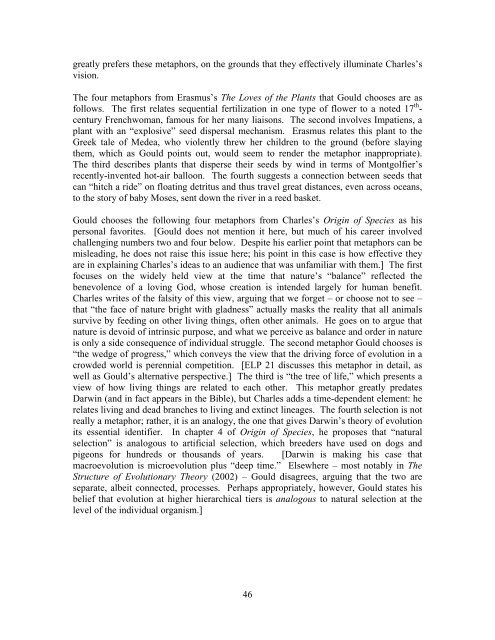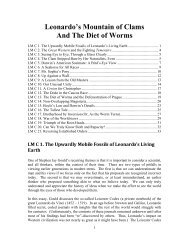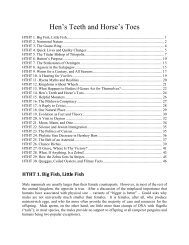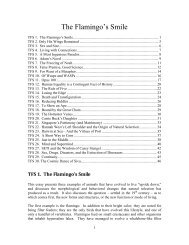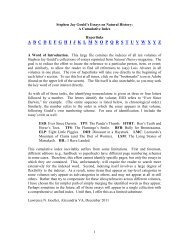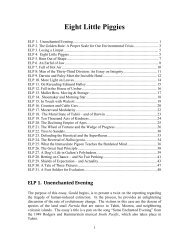Dinosaur In a Haystack - A Website About Stephen Jay Gould's ...
Dinosaur In a Haystack - A Website About Stephen Jay Gould's ...
Dinosaur In a Haystack - A Website About Stephen Jay Gould's ...
Create successful ePaper yourself
Turn your PDF publications into a flip-book with our unique Google optimized e-Paper software.
greatly prefers these metaphors, on the grounds that they effectively illuminate Charles’svision.The four metaphors from Erasmus’s The Loves of the Plants that Gould chooses are asfollows. The first relates sequential fertilization in one type of flower to a noted 17 th -century Frenchwoman, famous for her many liaisons. The second involves Impatiens, aplant with an “explosive” seed dispersal mechanism. Erasmus relates this plant to theGreek tale of Medea, who violently threw her children to the ground (before slayingthem, which as Gould points out, would seem to render the metaphor inappropriate).The third describes plants that disperse their seeds by wind in terms of Montgolfier’srecently-invented hot-air balloon. The fourth suggests a connection between seeds thatcan “hitch a ride” on floating detritus and thus travel great distances, even across oceans,to the story of baby Moses, sent down the river in a reed basket.Gould chooses the following four metaphors from Charles’s Origin of Species as hispersonal favorites. [Gould does not mention it here, but much of his career involvedchallenging numbers two and four below. Despite his earlier point that metaphors can bemisleading, he does not raise this issue here; his point in this case is how effective theyare in explaining Charles’s ideas to an audience that was unfamiliar with them.] The firstfocuses on the widely held view at the time that nature’s “balance” reflected thebenevolence of a loving God, whose creation is intended largely for human benefit.Charles writes of the falsity of this view, arguing that we forget – or choose not to see –that “the face of nature bright with gladness” actually masks the reality that all animalssurvive by feeding on other living things, often other animals. He goes on to argue thatnature is devoid of intrinsic purpose, and what we perceive as balance and order in natureis only a side consequence of individual struggle. The second metaphor Gould chooses is“the wedge of progress,” which conveys the view that the driving force of evolution in acrowded world is perennial competition. [ELP 21 discusses this metaphor in detail, aswell as Gould’s alternative perspective.] The third is “the tree of life,” which presents aview of how living things are related to each other. This metaphor greatly predatesDarwin (and in fact appears in the Bible), but Charles adds a time-dependent element: herelates living and dead branches to living and extinct lineages. The fourth selection is notreally a metaphor; rather, it is an analogy, the one that gives Darwin’s theory of evolutionits essential identifier. <strong>In</strong> chapter 4 of Origin of Species, he proposes that “naturalselection” is analogous to artificial selection, which breeders have used on dogs andpigeons for hundreds or thousands of years. [Darwin is making his case thatmacroevolution is microevolution plus “deep time.” Elsewhere – most notably in TheStructure of Evolutionary Theory (2002) – Gould disagrees, arguing that the two areseparate, albeit connected, processes. Perhaps appropriately, however, Gould states hisbelief that evolution at higher hierarchical tiers is analogous to natural selection at thelevel of the individual organism.]46


